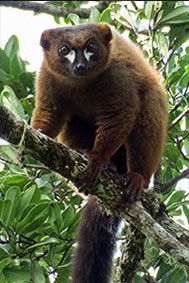Red-bellied Lemur
Eulemur rubriventer
Conservation status
Vulnerable (IUCN Red List, 2021)
Family
Lemuridae
What they look like
Red-bellied lemurs are a medium-sized primate and weigh about 3½ to 5 lbs. They are a sexually dichromatic species: males and females differ in their pelage coloration although not in overall body size. Males (pictured), but not females, have a conspicuous patch of white skin beneath each eye giving the appearance of a “tear-drop” pattern. The males have long, dense fur on their backs that is a deep chestnut-brown color, and their bellies are lighter colored with more red. Female red-bellied lemurs have the same deep chestnut-brown fur on their backs. However, they have very distinct creamy-white fur on their bellies which may extend all the way up to the cheeks. Males have more dense fur around their ears giving them a face that appears more robust.Females have a similar coloration on their faces, but appear slimmer since they lack the long bushy cheek hairs of the male.
Where they live
This species can be found in intact rain forests along eastern Madagascar including northeastern Madagascar with the exception of Masoala National Park. They occur as far north as the Tsaratanana massif where they have been found at high elevations up to 2,400 meters. They occur at lower population densities than many other Eulemur species.
What they eat
Red-bellied lemurs are considered to be good seed dispersers. The majority of their diet consists of fruit, flowers, nectar, and leaves. They are known to eat a large variety of plants—over 70 different species. They have also been observed eating introduced plant species like Chinese guava. Seasonally available insects as well as soil and fungus also comprise a small portion of their diet.
How they behave
Like many other Eulemur species, red-bellied lemurs show a cathemeral activity pattern, meaning they are active both during the day and at night throughout the year. Groups are “pair bonded,” comprised of an adult male/female pair plus offspring and can be as large as 10 individuals. Group travel is often led by the adult female.
How they reproduce
Typically, only a single infant is born each year although twinning is not unusual. Females are sexually receptive (estrus) for only a 24-hour period. Mothers usually give birth in September or October. Young infants will ride on both mom and dad. Male infant care is unusually frequent in this species. The males will continue to carry their offspring up to the age of 100 days. Infant mortality is approximately 50% in this species.
What threats they face
These lemurs face many threats including habitat loss due to slash-and-burn agriculture, illegal logging, and hunting.
Red-bellied lemurs in Marojejy National Park and Anjanaharibe-Sud Special Reserve
In Madagascar, these lemurs can be found in five national parks, two strict nature reserves, and six special reserves, including Anjanaharibe-Sud Special Reserve (ASSR). At least one group has been found near Camp Indri in ASSR.
